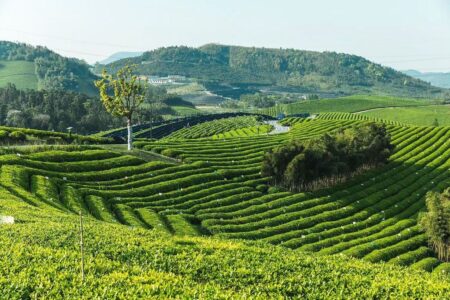Peet’s Coffee: Influencing the Industry for 50 Years

Age and expansion have not waned Peet’s Coffee’s passion for specialty coffee. Peet’s Coffee is as committed to crafting exceptional coffee today as it was fifty years ago when Alfred Peet hand roasted the first batch of coffee in his small shop.
Often called the “grandfather of specialty coffee,” Alfred Peet, the founder of eponymous specialty roaster, helped carve out the craft coffee movement in the United States while inspiring a new generation of coffee entrepreneurs along the way. However, when he emigrated to the US, creating a specialty coffee movement was not his priority. His goal was a simple one: he wanted Americans to drink better coffee.
Leading up to World Word II, American coffee consumption was high, averaging 20 pounds for every adult, noted Patrick Main, senior R&D manager at Peet’s Coffee. However, wartime rationing impacted coffee’s availability and its quality in the US, prompting the development of product that was “stretched” to increase yield and meet demand. Even after the war ended, he said, coffee brands continued to produce low cost, low quality blends that soon dominated the market. “Americans got used to bland, uninspiring coffee from a tin can.”
Alfred Peet grew up in the coffee trade, working in his father’s roaster in Alkmaar, Holland. After World War II, he worked in the tea trade in Indonesia and eventually landed in San Francisco, California, where he was employed by a coffee importer. Main, who first encountered Alfred Peet as a young barista serving him cappuccino, said that he “could not understand why the richest country in the world was drinking such terrible coffee, so he set out to do something about that.” While the coffee market was in much need of a change, the concept was definitely a gamble, as no one in the US was doing what Peet wanted to do.
Peet’s ideas were extremely progressive. “No one was talking about the differences in coffee origins back then, or about freshness or meticulous brewing,” said Main. “And certainly no one was roasting coffee the way he did, with a deep, dark sweetness and full, rich body.” It was in Berkeley, just north of San Francisco, where Peet discovered his first potential market. Here, he found a community of highly educated, international consumers who Peet thought would understand and appreciate what he was doing.
The challenge remained to find the perfect location that would begin the conversation of freshly roasted, hand-crafted coffee. The solution was a former paint store at the corner of Vine and Walnut Streets, just north of the University of California-Berkeley campus (which later became known as the Gourmet Ghetto). The shop, featuring a 25-pound capacity drum roaster, was transformed into the inaugural Peet’s Coffee, Tea, and Spices, which opened its doors 1 April 1966.
Peet’s intent was not to become a coffee shop proprietor. Instead, he considered his establishment a place to learn about and buy fresh-roasted Arabica coffee from around the coffee-growing world. “He was not particularly interested in running a café but knew that he needed to provide a way for customers to taste his coffee – brewed correctly – so they would have an example of how their coffee should taste when they brought it home to brew,” said Main. In fact, when the original store opened, there were only two things on the menu: brewed coffee (one size) and tea brewed by the pot.
Using his Royal #5 drum roaster (manufactured by the A.J. Deer Co.), Peet tinkered with the roasts. He experimented with several different brewing methods of varying levels of complexity and eccentricity before settling on a restaurant-style urn to keep up with the booming demand. The coffees rotated giving customers the opportunity to explore the full range of coffee he had to offer. By delivering a premium product and educating the palates of his Berkeley neighbours, Peet taught his growing consumer base the value of superior quality coffee. Word spread and over time, Peet gained a loyal following. His customers even began referring to themselves as “Peetniks.”
The second Peet’s Coffee shop opened in 1971 on Santa Cruz Avenue in Menlo Park, Calif. The specialty coffee chain’s expansion has been slow and methodical. “To quote our CEO, Dave Burwick, Peet’s Coffee is ‘scaling the smallness,’” said Main. “Just as Mr Peet was careful in selecting his first location, we’re mindful about where we go. We want to be in the right geographies and in the right grocery chains—where people are willing to pay that premium and where there are people who truly appreciate coffee.”
Peet’s expanded primarily around the San Francisco Bay area before moving into new regions, beginning with Southern California in the mid-1990s. In addition to California, Peet’s, now headquartered in Emeryville, Calif., operates 400-plus cafés throughout Colorado, Illinois, Massachusetts (Boston), New York (New York City) and the Washington, DC metro area.
The name “Peet’s Coffee, Tea, and Spices” was shortened to Peet’s Coffee and Tea in the early 1980s. The name was reduced yet again in 2015 after the company combined Mighty Leaf Tea (which Peet’s acquired in 2014) and Peet’s Tea into a single premium tea line. “We modified our name to ‘Peet’s Coffee’ as a reflection of what our founder, Alfred Peet established 50 years ago: an obsessive commitment to crafting exceptional coffee,” said Main.
It’s Still All About the Roast
A long time has passed since the first batch of coffee was roasted on that 25-lb drum roaster. The company now uses Probat R1500 and R2000 roasters, which can roast several hundred pounds at a time rather than just twenty-five. However, while the technology and machinery have improved to meet demand, Peet’s approach to roasting coffee remains the same—it is still done in individual small batches. “Our roasting hasn’t changed much in a technical sense,” said Main, adding that each Probat is still tended to by a dedicated craftsman who is using senses honed through years of apprenticeship and practice. “Every bean of Peet’s coffee is roasted in this way, by one of twelve people who have undergone years of extensive training.” Combined with its strong infrastructure, Peet’s can roast and ship any order within twenty hours.
Alfred Peet distinguished himself with coffee that had a “deep, dark sweetness and full, rich body”—a style that no one else was offering and one in which the company maintains today. “No one else has ever been able to duplicate our dark roast style. It’s a delicate process to bring out the complexity of the origin character,” said Main. Although known for its dark roast style, Peet’s also offers medium- and light-roasted coffee.
The opening of the shop in 1966 was revolutionary. In fact, it has been described as the ‘Big Bang of specialty coffee in the US.’ That is, the singular person, place and time that sparked an entirely new way for Americans to enjoy and appreciate coffee, Main explained. To celebrate its 50th anniversary, Peet’s is offering a special medium roast blend named Big Bang in honour of Alfred Peet’s legacy and influence. The Big Bang blend features Ethiopian Super Natural coffee and offers an exotic, bright and aromatic fruitiness. It is currently available in Peet’s cafés nationwide, in grocery stores and online.
Unwilling to Compromise Its Standards
Although its core business remains its cafés, Peet’s developed a grocery-line without comprising its high quality standards—a difficult task to achieve in mass market retail where coffee is typically roasted in large batches and stored in warehouses for lengthy periods of time before being shipped to stores. The company made its first foray into grocery distribution in 2000. “That part of our business grew slowly at first because we were not willing to budge on freshness standards and it was impossible to expand our distribution using traditional warehouse distribution models,” said Main.
Peet’s now boasts distribution in more than 14,000 grocery stores. It invests in direct store delivery (DSD) to personally supply and monitor grocery store shelves to ensure freshness standards for coffee are met and the full selection is available. Within the DSD network, route managers are responsible for stocking Peet’ coffees on store shelves, rotating stock and removing older product if needed. “As a result, we are able to offer significantly fresher coffee on grocery shelves than any other national brand,” Main said, adding that this approach is a key differentiator where the industry standard has been brands relying on grocery store employees to stock shelves and monitor inventory.
Influencing Coffee Entrepreneurs
Alfred Peet disrupted the coffee industry from his small Berkeley shop with his innovative approach that was unlike anything Americans had tasted before. “Many like-minded entrepreneurs soon took notice and were eager to learn from Mr Peet,” said Main. “He was very generous with his knowledge.” So generous in fact, that when three young academics approached him to learn his techniques, “Mr Peet readily engaged and taught them the art of an exceptional cup.”
The three academics – Jerry Baldwin, Zev Siegel and Gordon Bowker – opened their first Starbucks Coffee store in Seattle, Washington, in 1971. Their coffee was sourced and roasted by Peet, who eventually taught them how to roast and helped them to set up their own roasting operations.
George Howell, another influential coffee pioneer, “has said that his life changed when he wandered into Mr Peet’s shop in Berkeley,” shared Main. “He moved from Berkeley to Boston, and inspired by Peet’s, founded the ground-breaking Coffee Connection in 1975 (later renamed George Howell Coffee).”
The founder’s philosophy still influences Peet’s approach to sourcing and roasting coffee, and its commitment to sustaining the future of coffee. It is this commitment to Alfred Peet’s hand-crafted philosophy that inspired other game changers in the industry including the founders of Stumptown Coffee and Intelligentsia Coffee, who, Main noted, each started as baristas at Peet’s.
Sustaining the future of coffee has also influenced the facility where Peet’s roasts its coffee. Peet’s Alameda Coffee Roastery, for example, is the first LEED-certified coffee roasting facility in the US and the first LEED Gold-certified building in the city of Alameda. LEED is the nationally accepted benchmark for the design, construction and operation of high performance green buildings. LEED promotes a whole-building approach to sustainability by recognizing performance in five key areas of human and environmental health: sustainable site development, water savings, energy efficiency, materials selection and indoor environmental quality. Peet’s Roastery achieved LEED certification because it proved sustainable design and construction in those five areas.
Furthering its sustainability efforts, Peet’s recently pledged USD $250,000 to the University of California-Davis to help establish the world’s first university research hub focused on post-harvest studies of coffee. The donation by Peet’s will be used to establish the Peet’s Coffee Pilot Roastery that will be housed in the new Coffee Center. (See T&CTJ October 2016)
Alfred Peet’s legacy continues to transform the industry today. From the ‘Big Bang’ of the first location, his vision and philosophy of roasting coffee has influenced a new generation of coffee entrepreneurs and can be credited with essentially launching a premium coffee segment in the US. “Mr Peet’s revolutionary ideas of 50 years ago have flourished and evolved, whereby providing a template for the burgeoning creativity and energy of today’s specialty coffee industry,” affirmed Main.



